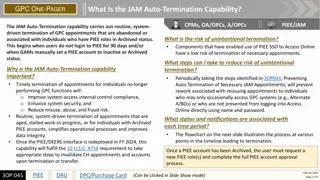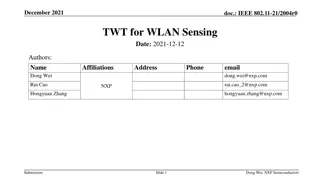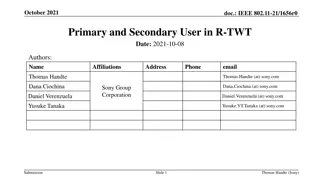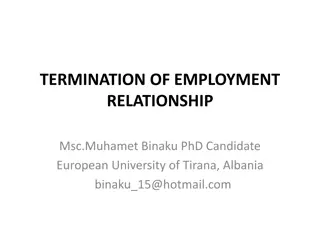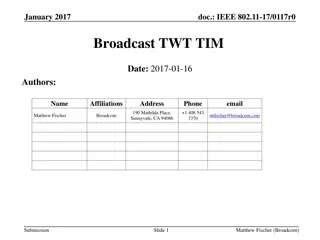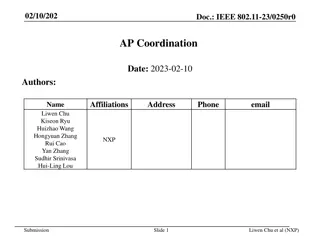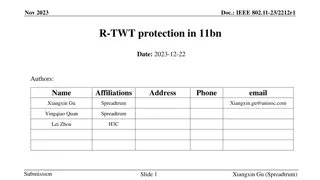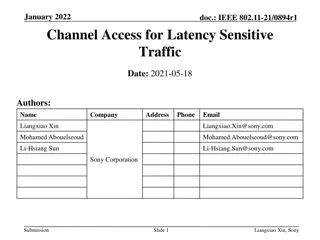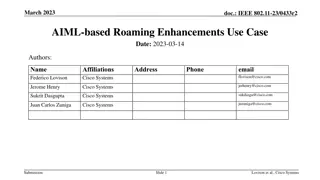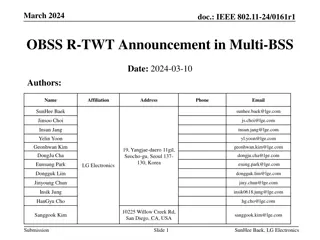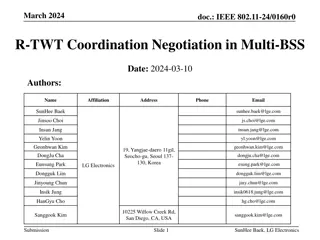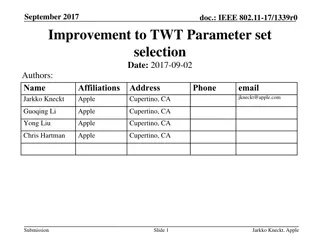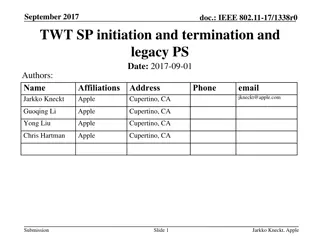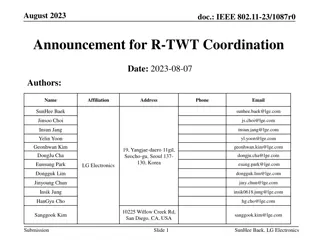Enhancements for TWT SP Early Termination in IEEE 802.11-22/0304r0
In the IEEE 802.11-22/0304r0 document, enhancements are proposed for supporting latency-sensitive traffic by introducing additional improvements to the TWT SP early termination feature. These enhancements aim to facilitate efficient termination of the restricted TWT SP, allowing STAs to enter the doze state and save power while ensuring timely delivery of traffic. Considerations for terminating r-TWT memberships are discussed, highlighting the need for effective termination mechanisms and the importance of addressing missing handshake issues in termination scenarios.
Download Presentation

Please find below an Image/Link to download the presentation.
The content on the website is provided AS IS for your information and personal use only. It may not be sold, licensed, or shared on other websites without obtaining consent from the author. Download presentation by click this link. If you encounter any issues during the download, it is possible that the publisher has removed the file from their server.
E N D
Presentation Transcript
IEEE 802.11-22/0304r0 July 2022 Restricted TWT SP Early Termination Date: 2022-07-08 Affiliations Address 1180 Discovery Wy, Sunnyvale, CA Phone email Name M. Kumail Haider kumail.lums@gmail.com Chunyu Hu Meta Chitto Ghosh Binita Gupta Slide 1 Submission M. Kumail Haider et. al., Meta
IEEE 802.11-22/0304r0 July 2022 Abstract For supporting latency sensitive traffic, restricted TWT (r-TWT) is defined in 11be. r-TWT membership is associated with a set of DL/UL TIDs (r-TWT TIDs). If the latency sensitive traffic has been delivered and the r-TWT SP still has time remaining, terminating the SP can help STA enter doze state and save power, when applicable In this contribution, we propose additional enhancement, on top of TWT SP early termination in baseline, to support the r-TWT SP termination. Related LB266 CIDs: o 10693, 10917, 12270, 12275, 13041, 13106, 13108, 13234, 13664 Slide 2 Submission M. Kumail Haider et. al., Meta
IEEE 802.11-22/0304r0 July 2022 Background: 11ax TWT SP Termination In 11ax spec, when a TWT SP termination is detected by a STA within the TWT SP, the STA may transition to the doze state r-TWT SPs may be terminated using the same baseline mechanism as r-TWT is based on b-TWT As per baseline, a STA can classify any of following events as a TWT SP termination (26.8.5) The transmission by the STA of an acknowledgment in response to an individually addressed QoS Data or QoS Null frame sent by the AP that had the EOSP subfield equal to 1 The transmission by the STA of an acknowledgment in response to an individually addressed frame that is neither a QoS Data frame nor a QoS Null frame, sent by AP with the More Data field equal to 0. The reception of a Trigger frame sent by the TWT responding STA or TWT scheduling AP that has the More TF field equal to 0 and is not addressed to the TWT requesting STA or TWT scheduled STA provided that the TWT requesting STA or TWT scheduled STA is either awake for an announced trigger-enabled TWT SP but didn t transmit an indication that it is in the awake state to the TWT responding STA or TWT scheduling AP, or is awake for an unannounced trigger-enabled TWT SP. Slide 3 Submission M. Kumail Haider et. al., Meta
IEEE 802.11-22/0304r0 July 2022 Termination considerations for r-TWT r-TWT membership is set up associated with a set of TIDs (TIDs_L) in UL/DL Prior discussions: o 11-21/1115r1: CC36-CR-35.6 Traffic Prioritization During Restricted TWT SPs When the traffic in TIDs_L is delivered and there is still time remaining, the r-TWT SP should be terminated Helps STA s PS if it does not have more traffic, it may go to sleep o However, there is some gap to facilitate the termination to happen effectively/efficiently in the current spec o Related CC36 CIDs: 4765, 6866, 5875, 7471, 8052, 6969 (deferred to D2.0) o Related LB266 CIDs: 10693, 10917, 12270, 12275, 13041, 13106 Slide 4 Submission M. Kumail Haider et. al., Meta
IEEE 802.11-22/0304r0 July 2022 Problems(1): Missing handshake in Termination In termination scenarios described in 26.8.5, AP decides if/when to terminate and signals termination. It is not required for AP to check STA s buffer status before terminating For buffer status, the AP: Has to use BSRP to trigger explicitly (additional overhead), OR Rely on/wait for non-AP STA to voluntarily report empty buffer status as implicit indication of being ready to terminate SP ; no explicit signal/request to terminate Slide 5 Submission M. Kumail Haider et. al., Meta
IEEE 802.11-22/0304r0 July 2022 Proposal (1) When an r-TWT scheduled STA has completed the delivery of its buffered QoS Data frames of r-TWT UL TID(s), and if there is still remaining time in the current r-TWT SP, it should indicate empty buffer status to the AP for the corresponding TIDs When an r-TWT scheduling AP has completed the delivery of its buffered QoS Data frames of r-TWT DL TID(s), and if there is still remaining time in the current r-TWT SP, it should ensure empty buffer indication of r-TWT UL TID(s) is received from the STA before terminating the SP (if intended) When an r-TWT scheduling AP has completed delivery of its buffered QoS Data frames of r-TWT DL TID(s), and if it receives empty buffer indication from the r-TWT scheduled STA corresponding to r-TWT UL TID(s), it should terminate the on-going r-TWT SP for that r-TWT scheduled STA Slide 6 Submission M. Kumail Haider et. al., Meta
IEEE 802.11-22/0304r0 July 2022 Problems(2): Gaps in BSR/termination signaling In termination scenarios discussed in 26.8.5, STA cannot initiate a termination negotiation/event1 STA may initiate termination if it delivered all LST traffic, instead of delivering BSR first to save overhead. STA may also need to terminate for PS or scenarios such as thermal throttling/PHY calibration etc. Gaps in Buffer Status Report mechanism o In trigger-enabled TWT, or if the non-AP STA supports UL MU, then AP can inquire buffer status using BSRP. However: o Problem 1: BSR A-control reports buffer status for AC, not TID o Problem 2: QoS-Control reports status per TID, but Queue Size is for one TID o Note: STA could aggregate up to 8 QoS Control in Qos Null to report buffer of all desired TIDs (which needs Multi- TID BA to respond): added overhead and onerous effort. o Problem 3: Queue Size for both BSR Control and QoS Control has to include buffer for any DATA in carrying frames, and the report may not be precise due to scaling factor-based encoding (see slide 17). Cannot always clearly convey that DATA included in carrying frame is the only remaining buffer o Termination notification in QoS DATA o AP can indicate EOSP=1 or MoreData=0 in QoS DATA frame to terminate (to save additional frame/QoS NULL to indicate termination) (see slide 3 and 26.8.5) o However, if multiple MPDUs are included, SP will be terminated even if some MPDUs are not ACKed [1] With the exception that STA may suspend schedule using TWT Information frame, but this method requires sending separate management frame and suspends all future occurrences of schedule Slide 7 Submission M. Kumail Haider et. al., Meta
IEEE 802.11-22/0304r0 July 2022 Proposal(2): Add new explicit signaling for TWT SP Termination[1] Enable (r-)TWT scheduled STA to directly signal the readiness to terminate an SP Proposal: add a new HE-variant A-control field TWT SP Command Control ID (4b) = value for <TWT SP Command> Control Information (variable) Rsvd (1b) TID (4b) Last SN (12b) Command (3b) Command Description TID | Last SN 0 Request the receiver to terminate the SP when the receiver runs out of buffers of TIDs_L traffic for the transmitting STA. Reserved. 1 Request the receiver to terminate the SP when the receiver runs out of buffers of TIDs_L traffic for the transmitting STA and when: the receiver has received all SNs <= <Last SN> for <TID> and acknowledged them. 2 Request the receiver to terminate the SP. Reserved 3 Notify the receiver that SP will be terminated when: the receiver has received all SNs <= <Last SN> for <TID> and acknowledged them. 4 Notify the receiver that SP is being terminated Reserved 5-7 Reserved Reserved Slide 8 Submission [1] Could be unified with proposed extension signaling; see 22/303r0 M. Kumail Haider et. al., Meta
IEEE 802.11-22/0304r0 July 2022 Illustrative Examples In the next few slides, we discuss a couple of termination scenarios and compare how termination is signaled using existing methods, and the proposed method Objective is to illustrate that new signaling saves overhead and clearly indicates the intention and conditions for termination. Submission
IEEE 802.11-22/0304r0 July 2022 Example 1: AP runs out of DL traffic first STA sets up membership in an r-TWT schedule with TIDs 2, 3 in UL and DL During an r-SP, AP runs out of traffic first and checks if SP may be terminated SP Termination with existing signaling: o After delivering DL traffic, AP checks STA buffer for TIDs_L before terminating. If STA has pending BUs, it may take multiple runs of signaling in order to terminate SP Original r-TWT SP AP does not have more DL BUs for TID 2 and 3 so checks STA buffer before terminating AP sends last 60 MPDUs of TID 3 AP indicates EOSP=1 to terminate Basic Trigger QoS Null Beacon DL SU PPDU BSRP BA AP TB PPDU (QOS DATA) STA (QoS NULL) ACK BA TB PPDU NOTE: STA may also indicate BSR here. However, it has to include buffer for MPDUs in carrying frame and due to scaling factor in QoS Control/BSR Control, not always possible to specify exact bytes pending STA ACKs and SP is early terminated STA indicates empty buffer for TIDs 2 and 3 Slide 10 Submission M. Kumail Haider et. al., Meta
IEEE 802.11-22/0304r0 July 2022 Example 1: AP runs out of DL traffic first STA sets up membership in an r-TWT schedule with TIDs 2, 3 in UL and DL During an r-SP, AP runs out of traffic first and checks if SP may be terminated SP Termination with new proposed signaling: o After delivering DL traffic, AP checks STA buffer for TIDs_L before terminating. If STA has pending BUs, it may take multiple rounds of signaling in order to terminate SP Original r-TWT SP AP sends 60 last remaining MPDUs to STA (seq 1-60), and indicates no more buffer in TWT SP Command field Command:1 Last SN:60 TID:3 DL SU PPDU AP ACKs all MPDUs until SN X for TID 2, and SP is terminated Basic Trigger Beacon BA AP TB PPDU (QOS DATA) STA BA STA still has more data for TID 2, so not ready to terminate yet STA also sends its remaining BUs, and notifies AP that SP will be terminated after all UL BUs are ACKed (using TWT SP Command field) Command:4, Last SN: X, TID: 2 Slide 11 Submission M. Kumail Haider et. al., Meta
IEEE 802.11-22/0304r0 July 2022 Example 2: STA runs out of UL traffic first STA sets up membership in an r-TWT schedule with TIDs 2, 3 in UL and DL During an r-SP, STA runs out of traffic first and wants to terminate SP Termination with existing signaling: o STA first delivers its traffic and then indicates zero buffer to AP after it is triggered. AP waits to deliver its DL BUs and then terminates Original r-TWT SP AP includes 30 DL BUs for TIDs 3 in AMPDU. AP doesn t have more BUs for TID 2 or 3 but it should not indicate termination yet as all DL BUs are not ACKed. AP ACKs all 60 MPDUs AP indicates EOSP=1, indicating termination Basic Trigger Basic Trigger Beacon QoS NULL BA QoS DATA ACK AP STA ACK QoS Null BA TB PPDU STA ACKs and SP is early terminated STA sends 60 MPDUs of TID 2, doesn t have BUs for TID 3 STA doesn t have more UL BUs, so it indicates empty buffer for all TIDs_L by including QoS Control for each TID Slide 12 Submission M. Kumail Haider et. al., Meta
IEEE 802.11-22/0304r0 July 2022 Example 2: STA runs out of UL traffic first STA sets up membership in an r-TWT schedule with TIDs 2, 3 in UL and DL During an r-SP, STA runs out of traffic first and wants to terminate SP Termination with new proposed signaling: o STA delivers its traffic and requests AP to terminate after receiving all MPDUs in current PPDU. AP notifies SP is terminated after STA ACKs all DL MPDUs Original r-TWT SP AP ACKs all 60 MPDUs AP now knows STA has no BUs for TIDs_L MPDUs until SN 130, by including new TWT SP A-Control with following: Command:3, TID:3, Last SN:130 AP includes DL BUs for TID 3 in AMPDU (SN 101-130). AP doesn t have more BUs so it indicates to STA SP will be terminated after STA ACKs Basic Trigger Beacon BA QoS DATA AP STA BA TB PPDU STA ACKs all MPDUs and SP is early terminated A-MPDU with 60 MPDUs with SN 1-60 <TWT SP A-Control>: Command: 1* TID:2 Last SN = 60 Slide 13 Submission M. Kumail Haider et. al., Meta
IEEE 802.11-22/0304r0 July 2022 Summary Discuss the need for r-TWT SP early termination Propose a signaling design to early terminate an r-TWT SP Slide 14 Submission M. Kumail Haider et. al., Meta
IEEE 802.11-22/0304r0 July 2022 Straw polls SP1: Do you agree to add a new HE variant A-control field to signal TWT SP Termination (an example is described in Slide 8, but exact format/names are TBD)? Slide 15 Submission M. Kumail Haider et. al., Meta
IEEE 802.11-22/0304r0 July 2022 Backup Slides Slide 16 Submission M. Kumail Haider et al. FB
IEEE 802.11-22/0304r0 July 2022 Slide 17 Submission M. Kumail Haider et al. FB





